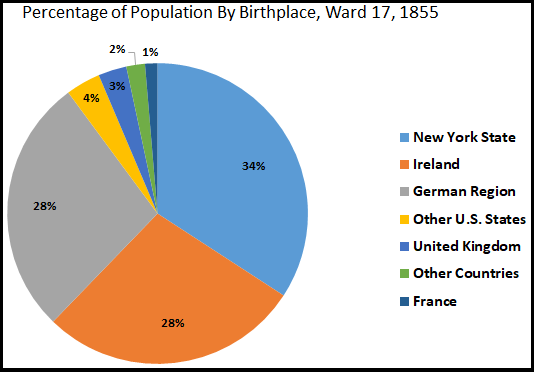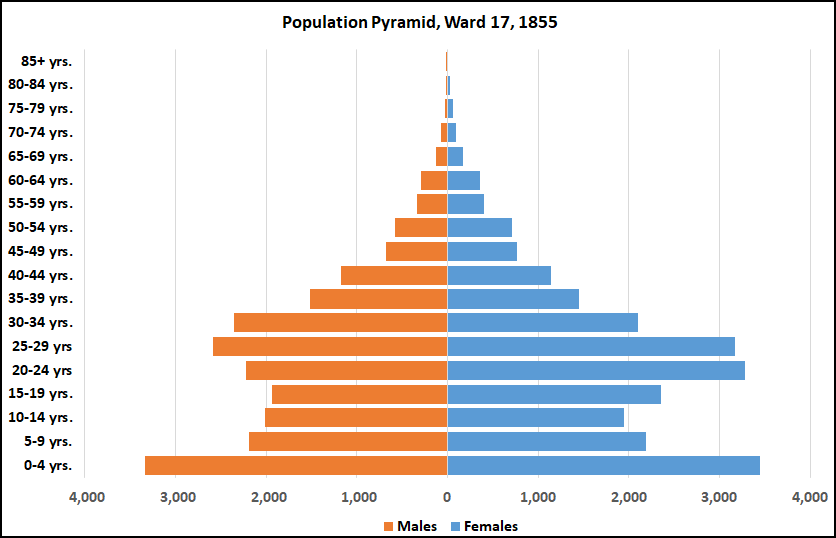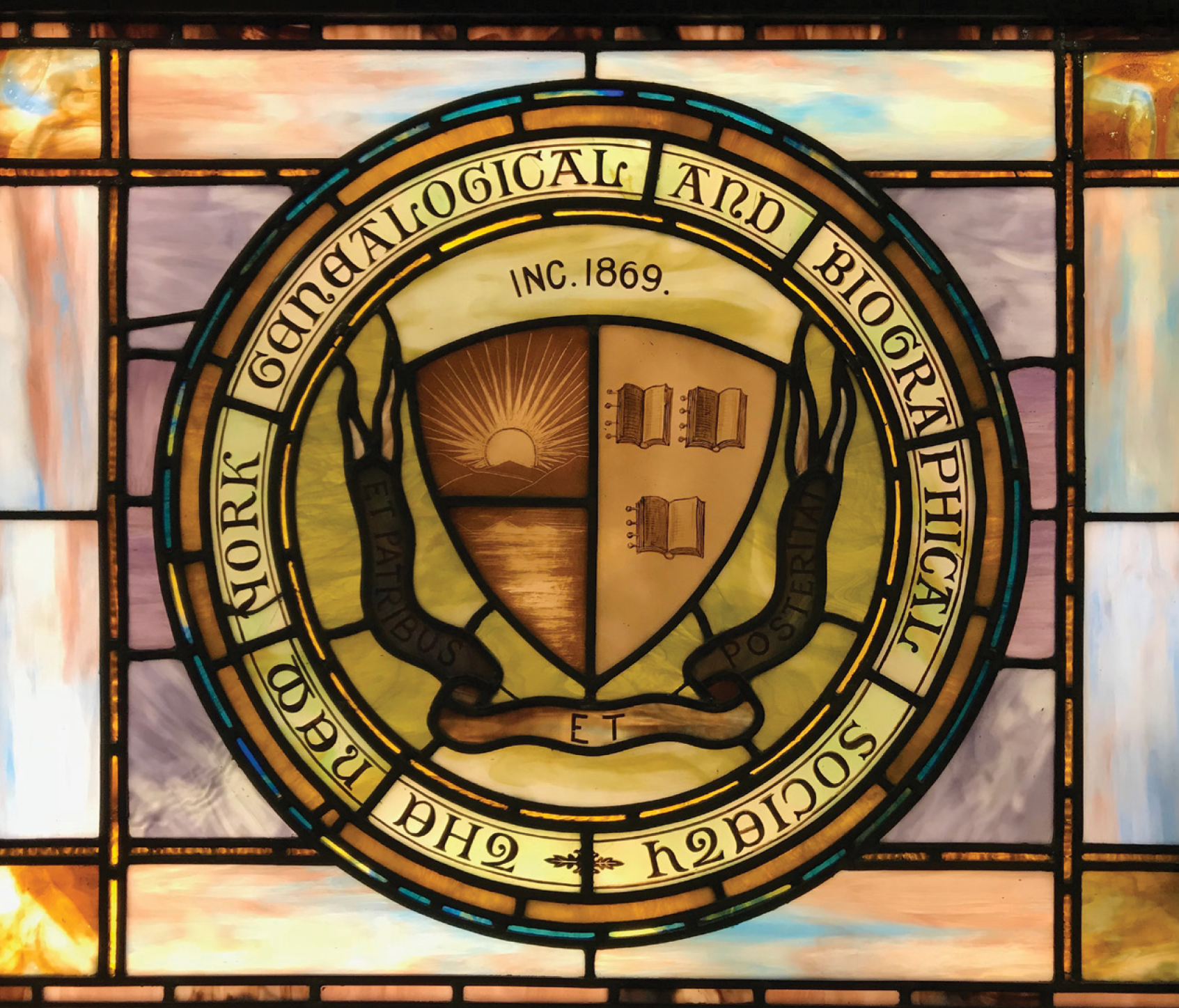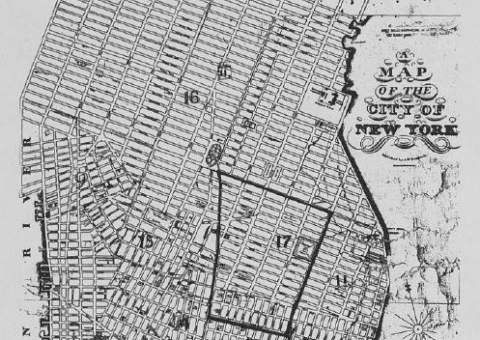One of the most exciting collections in the NYG&B eLibrary is the 1855 New York State Census for Ward 17 of New York City, located in Manhattan. Ward 17 was a neighborhood on the Lower East Side, where many immigrants settled after arriving in New York.
As we will detail below, this collection is very important for family history research, but thanks to the volunteers who indexed the entire collection in 2013, we were able to use the dataset they created to crunch some numbers and find out many fascinating facts about the population of this neighborhood of New York City.
As far as we know, this is the only demographic analysis done on this neighborhood during this time period - all other parts of the 1855 state census have not been indexed, which makes this kind of analysis almost impossible to conduct. Here's what we took a look at:
- The birthplaces of the residents of Ward 17
- The age and gender distribution of the population
- The most common professions listed
outlined on a nineteenth-century map of New York City.
About Ward 17
Ward 17 itself is a very important neighborhood in the history of New York City. More than 60,000 individuals from the densely populated, largely immigrant community were enumerated in the 1855 census.
The area was bounded on the north by Fourteenth Street, on the east by Avenue B and a part of Clinton Street, on the south by Rivington Street, and on the west by the Bowery and a small part of Fourth Avenue, spanning what is today much of the East Village and the Lower East Side.
This part of the Lower East Side was often referred to as “Little Germany” - Ward 17 was the residential heart of this neighborhood. The 1855 census enumeration for Ward 17 contained four physical books of records, and unfortunately, one of those books suffered severe water and insect damage - the contents of it are almost entirely unreadable.
Although the images of this book at included in the digital record set, our volunteers were unable to index most names in this volume. For this reason, the sample size for the statistics and charts below is 45,629 residents of Ward 17.
Ward 17 by birthplace
Overall, 62% of residents in Ward 17 were born outside of the U.S. - not surprising given that this geographical area has traditionally been a prime focus of immigrant arrivals and settlements.
The largest single segment was those born somewhere in New York State - nearly all of New York State's 62 counties were accounted for (New Yorkers were instructed to list the county of their birth; Americans born in other states listed the state of birth; and immigrants listed their country of birth).

England, Scotland or Wales. German immigrants sometimes listed municipalities
within the German Confederation, many of which would make up modern day
Germany.
Two groups - German and Irish - dominated the immigrant populations, together accounting for over half of the overall population of Ward 17.
A wealth of other nationalities and ethnicities were also present in the neighborhoods - there were people whose national origin traced back to nearly every other country in Europe and the British Isles as well as a number of people of Caribbean, South American, and Asian origin - 39 different countries of birth in total.
But by volume, the Germans, Irish and Americans dominated.
Gender and age distribution in Ward 17
Population pyramids are great ways to visualize a population based on age groupings and gender. Our chart shows the total number of males and females enumerated in the census for each age group.
Overall, the population was 47.5% male and 52.5% female. In general, the shape of the pyramid for Ward 17 indicates a quickly growing population - the largest groups appear toward the bottom of the period.

The vast majority of those aged 0-9 were born in the United States, while those more toward the middle of the pyramid were more commonly born outside of the United States.
We segmented the population between ages 20-34 and found that a whopping 83% were born outside of the United States.
Most common occupations
The 1855 census also asked residents for their profession. Here are the top ten most common answers:
- Tailor
- Laborer
- Carpenter
- Clerk
- Shoemaker
- Servant
- Merchant
- Mason
- Painter
- Banker
It's interesting to note that tailors and laborers were far and away the most common (almost twice as common as the next on the list, carpenter). Overall, there is a notable mix of what we would think of as middle and lower class occupations for this time period.
In some cases, particular professions were dominated by immigrants from a specific area. For instance, the vast majority of tailors were German, and laborers were most often born in Ireland.
About 19% of those who reported an occupation were women, who most often reported jobs involved in sewing and garment production.
Although they did not make the most common jobs reported, it is worth noting that there were also a not-insignificant number of artists, musicians, and actors living in this neighborhood as well.
Finding ancestors in Ward 17
The New York State 1855 census is a significant record set for family historians researching ancestors in New York State. Our eLibrary contains the only digitally available copy of the enumeration for one of the crucial immigrant neighborhoods of New York City. Many factors distinguish the 1855 census as a unique record set among its peers, and Ward 17 itself is a very special location.
We have a comprehensive guide to searching this collection to our New York Knowledge Base. This guide will be essential for anyone who would like to learn more about this record set or attempt to search it for ancestors.
The 1855 census is especially significant to family historians researching New York County (Manhattan) because it is the only surviving New York state census for that county until the 1905 census. It was also the first state census to ask for all names and family relationships of persons enumerated with the head of household.
The relation to head of household is particularly important - this information allows for great certainty about the composition of the household, and helps an otherwise puzzled family historian determine whether the older female listed with their ancestor’s family is the mother, aunt, or mother-in-law of the head of household, or a border who is not related at all.
Another vitally important question that this census asked was “Years resident in this city or town.” This information is of great help in trying to ascertain when an immigrant may have arrived in New York City.
Volunteer indexing effort - get involved!
After a monumental volunteer effort, the index of all four books of the 1855 New York state census for Ward 17 of Manhattan was completed in late 2013 and the transcription of the final book was added to the eLibrary in 2014.
Our volunteers made it possible to turn this record set into a fully searchable database, and in addition, we couldn't have look at these interesting statistics of the population without their hard work.
We hope you consider joining our volunteer team, which is currently working on a similar index for New York State religious records. Click here to learn more.
The NYG&B is proud to be able to offer this resource to our members, and gratefully thanks the many hard-working volunteers who made this project a success:
- Dr. Stanton F. Biddle, project leader
- Ginny Arveson
- Maria Baker
- Terri Berio
- Judy Boehm
- Helen M. Boyden
- Ann S. Bradburd
- Darryl W. Bridson
- Loretta C. Brown-Aldrich
- Noreen A. Burns-McDonald
- Mary MacIvor Conway
- Mary Beth Craven
- Mary Deka
- MaryAnn Diederich
- Diane Drugge
- Joan Dunne
- Marilyn A. Fannon
- Eve Fowler
- Barbara Gentry
- Marita J. Gladson
- Kathleen Hendrickson
- Beverly Kane
- Phebe A. Kirkham
- Eugene Gerard Klein
- Charles A. Laverty
- J. Douglas Leith
- Barbara Lewis
- Julia G. Lovett
- Erica Lu
- Sarah MacDonald
- Maureen Mahon
- Chris Miasnik
- Valerie Mills
- William Ford Mitchell
- Mary E. Morabito
- Robert Newman
- Christy Newman
- Nancy Nispel
- Kathleen A. O’Farrell
- Robert A. O’Leary
- Terri B. O’Neill
- Wendy L. Oborne
- Beverly Peterson
- Nanette G. Pezzutti
- Sheryl Porter
- Alexander Perry Scott
- Francis W. Sloat
- Edward H. L. Smith III
- Dianne A. Snook
- Kathleen Tesluk
- Kathleen Trevena
- Suzanne Warnecke
- Catherine Weber
- Melanie Weiss
- Talia Weissman
- F. John Wilkes, Jr.
- Scott T. Zukowski
More Genealogy Reading
-
7 resources to get you started with genetic genealogy
-
New York records now online: New York State Birth Index, NYC Almshouse Ledgers & NYC Bodies in Transit
-
11 Ways to use the NYG&B website to improve your skills and find ancestors
-
Why you need to have your ancestor's New York death certificate
-
Researching Irish ancestors in New York State: What you need to know
-
Surprising facts about immigration to New York
About the New York Genealogical and Biographical Society

a registered 501(c)(3) organization devoted to
preserving, documenting, and sharing the history of
New York State families. Read more about our mission.
Since 1869, our mission has been to help our thousands of worldwide members discover their family's New York story, and there has never been a better time to join.
The cost of an Individual Annual Membership is less than six dollars a month, and includes the following benefits:
- Access to over 50 exclusive digital record sets covering the entire state of New York, including the fully searchable archives of The Record.
- A complimentary subscription to all of Findmypast's North American records, as well as U.K. and Irish Census records.
- Access to hundreds of expert-authored Knowledge Base articles and webinars to help you navigate the tricky New York research landscape.
- Exclusive discounts and advanced access to conferences, seminars, workshops and lectures to learn more about researching people and places across New York State.
To learn more or join us, please visit our member benefits page.
